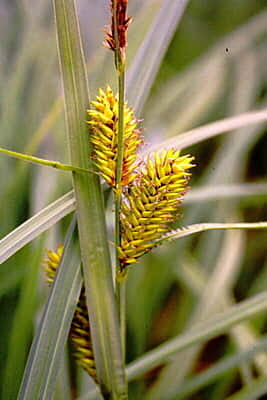



Carex lucustris (Lake Sedge) Seed 1 oz.
Lake sedge Description:
Carex lacustris, commonly known as lake sedge or shore sedge, is a perennial plant species that belongs to the family Cyperaceae. It is native to wetland habitats in North America and can be found growing in shallow water, on lake and river shores, and in other moist areas.
The plant typically grows to a height of 20 - 50 inches and has a clumping growth habit with narrow, grass-like leaves that are green in color. The leaves are typically 1/4 inch wide and have a fine texture. The stem of the plant is triangular in shape and can range in color from green to brown.
In late spring to early summer, Carex lacustris produces dense clusters of small flowers on spikelets that are held above the foliage. The flowers are typically brownish in color and are wind-pollinated. The plant then produces small, brown seeds that are dispersed by the wind.
Carex lacustris is an important component of wetland ecosystems, providing food and habitat for a variety of wildlife species, including birds, insects, and aquatic animals. It is also used in landscaping for its attractive appearance and ability to tolerate wet soil conditions. The plant is often used in wetland restoration projects, as well as in rain gardens, bioswales, and along pond edges to help control erosion, improve water quality, and promote water conservation. Carex lacustris is also known for its ability to filter and purify water, making it a valuable addition to water gardens and other aquatic environments.
Native Range:
Lake sedge is found natively in most parts of Minnesota with the exception of the far Southwestern regions of the state. More broadly, Lake sedge is found generally in the Midwest and Northeastern United States. That said, its range does extend as far west as Idaho.
Standard Plant Information:
Plant height: 20" - 50" inches
Fruiting time: June - July
Preferred habitat: Does well in part shade to full sun with wet soil. Often found in marshes, shores, swamps, wet meadows, swales, wet ditches, riverbanks, and edges of bogs and fens.
